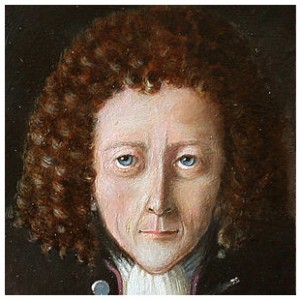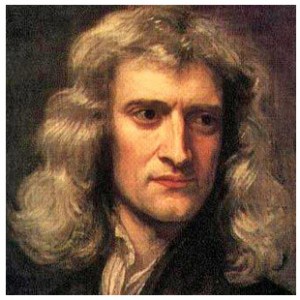GENIUSES AT ODDS
As of the mid-fifteenth century, human understanding of the universe and its workings on a scientific level had progressed little since the Ancient Greeks.

Conceptualized portrait of Robert Hooke by Rita Greer, 2004.
Aristotle, using the four elements of earth, air, fire and water, had explained how it all worked, and even after the fall of Greece and the ascendance of the Catholic Church, the Greek worldview remained paramount. It wasn’t until the Renaissance that thinkers such as Descartes and Galileo began to ask a different question, as explained by historian Edward Dolnick. “Aristotle had asked why. Why do rocks fall? Galileo asked how. How do rocks fall—faster and faster forever, or just until they reach cruising speed? How fast are they traveling when they hit the ground? Aristotle’s why explained the world, Galileo’s how described it.” And to the Italian, asking why things happen was “not a necessary part of the investigation.”
These new generations of thinkers saw God as a mathematician who had created all manner of rules and codes by which the universe operated, with humans just now uncovering the inner workings of his creation. “Science was a game that anyone could play, which meant that everything was up for grabs,” wrote Dolnick. “Anyone could propose a new idea, and no idea was exempt from challenge.” This was a substantial change in philosophy from the Medieval period, where authority was not to be questioned and curiosity was considered threatening. In England, the formation of the Royal Society in 1660 was a bold step into the modern world, bringing science “out of the library, into the laboratory.”
Robert Hooke (1635-1703) was an incredibly influential scientist of the 17th century, but his legacy has been overshadowed by other famous scientists of the period such as Newton. He served as curator of experiments for the Royal Society, orchestrating all sorts of demonstrations for members at meetings. Part of what made the Royal Society so radical was its commitment to plain and open discourse. The triumphs of one member would serve as inspiration and guidance for other members and for society at large. Hooke’s triumphs include improvements to the compound microscope which allowed him to study microorganisms more extensively than ever before; innovations to the telescope and air pump; early experiments with skin grafting, blood transfusion and artificial respiration; Hooke’s law of elasticity, which states the extension of a spring is in direct proportion to the load applied to it; and the coining of the term “cells.” He also used his architectural skill to help rebuild London after the Great Fire of 1666.

Portrait of Isaac Newton by Godfrey Kneller, 1689.
These thinkers saw God as a mathematician who had created all manner of rules and codes by which the universe operated.
Isaac Newton and his accomplishments in the areas of mathematics and physics are much more well-known to us. His work, Philosophia Naturalis Principia Mathematica (1687) defined the laws of motion and universal gravitation. Other triumphs of his include additional work to finally prove the solar system to be heliocentric; building the first reflecting telescope; studying the speed of sound; and the invention of calculus. The University of Cambridge appointed him a Professor of Mathematics and later in life, he would assume the presidency of the Royal Society. “His peculiar gift was the power of holding continuously in his mind a purely mental problem until he had seen straight through it,” wrote economist John Maynard Keynes. Hooke and Newton would correspond and one key area in which they [Hooke and Newton] came into conflict was the subject of light.
Hooke was a proponent of the wave theory of light, developed by Descartes, which held that light was made up of white wavelengths. Colored light occurred when white light passed through a lens or prism and became corrupted. This was the reigning theory during the 1600’s. However, Isaac Newton saw things differently, as he so often did. When experimenting with light passing through prisms, he noticed that the colored light refracted out of one prism could be reassembled back into a single beam of white light if allowed to pass through a second prism. Therefore, he hypothesized, that color must have been present in light all along and not caused by the corruption of the prism, as Hooke believed. Newton called his new discovery the particle theory of light, since light must have some substance in order to contain color.
Newton presented his findings to the Royal Society in 1672, but a number of the members (Hooke, most prominently) took offense at the challenge and criticized Newton’s conclusions. Upset by the criticism (something he would be unable to tolerate throughout his life), Newton withdrew his papers from publication preparations and would not engage in public scientific discussion for a decade, instead spending his time delving into alchemy and biblical scholarship. After Hooke died in 1703, Newton then chose to publish his findings on light in a book titled Opticks.
In Isaac’s Eye, Newton’s particle theory of light is what brings him to Hooke’s attention as the young scientist attempts to use his theory as a way to gain acceptance into the Royal Society. In actuality, Newton had already been accepted into the Royal Society before presenting his radical theory of light. The group had invited him to join their ranks after seeing the reflecting telescope that he had constructed, which was far more powerful than any other previous telescope (including many built by Hooke).
This is one example of the many areas in which playwright Lucas Hnath has taken creative liberties with the truth in order to tell a more dramatic story. However, in the spirit of these men who spent their lives discerning fact from fiction, Hnath has one of his characters chalk all true statements said about these great men during the course of the play onto the walls of the theatre. With the inclusion of this ingenious theatrical device, the audience can track what is real and what is invented for the sake of the story. To reveal any more details about Newton, Hooke or their many disagreements here, however, would risk spoiling the fun!
More on Isaac’s Eye:
Articles | Videos | Production Details | Tickets


2 Comments
I would like to refer to this piece in a book I am writing. How should I refer to it?
Hello Fernando,
Please credit Bobby Kennedy, the author of this article. His official title at Writers Theatre is Director of New Work & Dramaturgy.